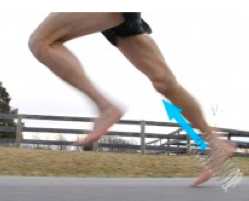Article
Running with Good Form
While it’s easy to describe good natural running technique principles, it’s much harder to learn them. This is where experiencing different stimuli, such as barefoot running, wearing minimalist running shoes, strength training, and using specific mental cues to activate your buttocks, can help.
Learning any new skill takes time and experimentation, so it’s better to think of it as a cycle rather than a linear progression with a fixed endpoint. You can always keep learning and evolving; new discoveries feed your progress and inspire new levels of performance, but you must be prepared to try and fail as part of the journey. This is where taking things slowly is all-important, as it keeps the magnitude of any failure small. For example, a bit of soreness and a day off running rather than a full-blown injury that keeps you out for months.
Form Principle 1: (Run Tall) Posture

Correct: 👍
● Run Tall – Imagine Your Column Being Stacked Under Your Head
● Look Straight Ahead to the Horizon
● The Ball of the Foot and Heel Are Level on the Ground
● To Move Forward, Lean in Like Giving a Kiss
Wrong: 👎
● Back-Seat Posture
● Bent Forward at Waist
● Body Adjustments to Heel Lift
Form Principle 2: Strong and Stable Core

Correct: 👍
● Core – Abdominals, Hips, and Glutes
● Strong and Stable While in Motion
● Proper Timing of Nerves and Muscles (Neuromuscular)
● Allows Optimal Energy Transfer From the Ground
Wrong: 👎
● Back Seat
● Head Forward
● Hip Dip Caused by Weak Hips
● Side-to-Side Motion
Form Principle 3: Arms and Hands

Correct: 👍
● Arms Set Rhythm
● Elbows at 90 Degrees or Less
● Relaxed Rearward Drive of Elbow
● Arms Reflexively Come Forward
● Knuckles Close to Sternum, Foot Always Lands Under Hand
Wrong: 👎
● Hands Should Not Cross Center
● Do Not Pump the Arms
● Arms Out in Front Along With Over Striding
Form Principle 2: Strong and Stable Core

Correct: 👍
● Feet Land Close to the Center
● The Full Foot Contacts the Ground
● Balance and Rhythm
● The Legs Store and Release Energy
● Use the Glutes To Get the Foot Down and Generate More Spring and Power
Wrong: 👎
● Over-Stride Forefoot Landing – Foot Stretched Out in Front
● Forefoot Landing Without Letting the Heel Settle Down (Running on the Balls of the Feet)
● Over-Stride Heel Landing
Form Principle 5: Cadence and Rhythm

Correct: 👍
● Harness the Energy From Your Springs
● Engage the Glutes and Pop Off the Ground
● Extend the Hips To Propel Forward
● Cadence 170 to 180 Steps per Minute
● Find Rhythm That Is Natural for Your Springs
Wrong: 👎
● Do Not Actively Lift Your Leg Upward; Let It Spring
● Slow Sticky Over-Stride Pattern – Uses Excessive Muscle Energy
● Cadence Too Fast and Over-Driving Spring
